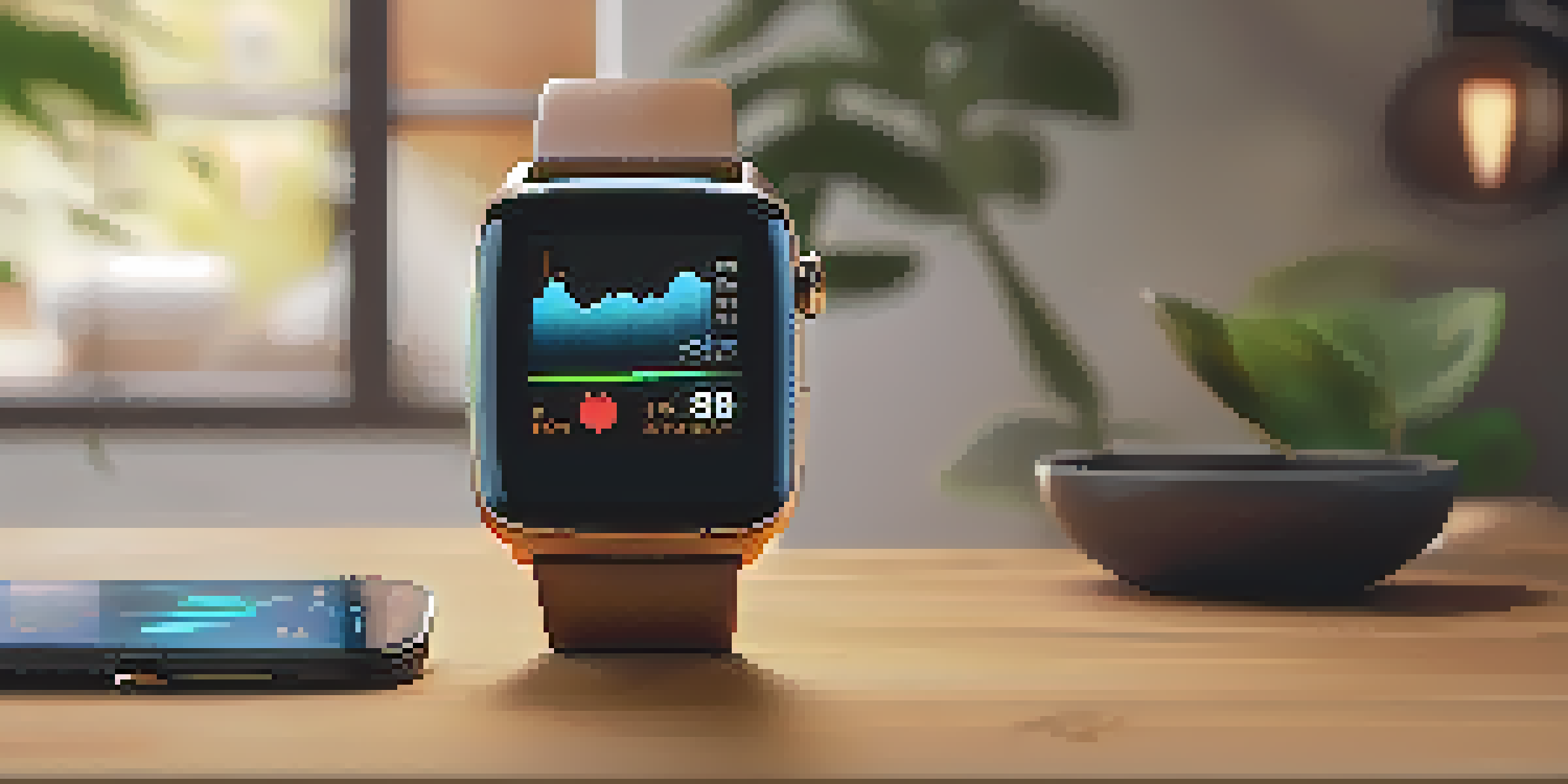Health Insights from Wearables: Data-Driven Wellness

Understanding Wearable Technology and Its Benefits
Wearable technology, like fitness trackers and smartwatches, has revolutionized the way we approach health and wellness. These devices collect data on various health metrics, such as heart rate, sleep patterns, and physical activity levels, providing users with valuable insights. By wearing these devices, individuals can gain a clearer understanding of their daily habits and health status, ultimately promoting a proactive approach to wellness.
Wearable technology is not just about tracking your steps, it's about transforming your health and wellness journey.
For instance, a fitness tracker can remind you to stand up after long periods of sitting, nudging you towards a more active lifestyle. This simple intervention can make a significant difference over time, highlighting how technology can foster healthy habits. Additionally, many wearables offer personalized feedback based on your unique data, making health management more tailored and effective.
As we embrace this technology, it’s essential to recognize that wearables are not just gadgets; they are tools that empower us to take charge of our health. With real-time feedback and actionable insights, we can make informed decisions that lead to improved physical and mental well-being.
The Role of Data in Personal Health Management
Data collected from wearables serves as a powerful ally in personal health management. By analyzing trends over time, users can identify patterns related to their sleep quality, stress levels, and exercise routines. This data-driven approach enables individuals to make adjustments that can enhance their overall well-being.

For example, if a user notices a consistent drop in sleep quality after late-night screen time, they can implement changes to their evening routine. This awareness can lead to better sleep hygiene and, consequently, improved energy levels and mood. The beauty of this data is that it’s personalized, allowing people to tailor their health strategies to what works best for them.
Wearables Enhance Health Awareness
Wearable technology empowers users to understand and manage their health through real-time data on metrics like heart rate and sleep patterns.
Moreover, wearables often sync with health apps that provide deeper insights and visual representations of data. This integration makes it easier to track progress and stay motivated while fostering a sense of accountability in managing one’s health.
How Wearables Promote Physical Activity
One of the most significant benefits of wearables is their ability to encourage physical activity. Many devices come equipped with features like step counters, workout tracking, and reminders to move, which can inspire users to be more active throughout the day. This gamification of fitness can make exercise feel less like a chore and more like an engaging challenge.
The greatest wealth is health.
For instance, competing with friends on step counts or earning badges for reaching fitness milestones can be a fun way to stay motivated. This social aspect not only enhances user experience but also fosters a community of support and encouragement. When you're part of a group striving for health goals, it can be easier to push through tough days.
Additionally, wearables can help users set realistic fitness goals based on their current activity levels. By gradually increasing targets, users can build their fitness without overwhelming themselves, ensuring that the journey towards better health is both sustainable and enjoyable.
Monitoring Sleep Patterns for Better Rest
Quality sleep is crucial for overall health, and wearables have made it easier to monitor sleep patterns. Many devices provide insights into sleep stages, duration, and disturbances, allowing users to understand their sleep quality. This data can be invaluable in pinpointing factors that affect rest, such as caffeine intake or evening screen time.
For example, if a user discovers they only spend a fraction of the night in deep sleep, they can explore changes that might enhance that restorative phase. This could involve adjusting bedtime routines or creating a more conducive sleep environment. The goal is to empower users with information that leads to better sleep hygiene and, ultimately, improved health.
Data-Driven Personal Health Insights
The data collected from wearables allows individuals to track trends and make informed adjustments to their lifestyle for better well-being.
Moreover, some wearables even offer guided breathing exercises or relaxation techniques based on stress levels detected during the day. These features can help users wind down effectively, marking a clear transition from daytime activity to restful sleep.
Tracking Heart Health with Wearable Devices
Heart health is a significant aspect of overall wellness, and wearables play a crucial role in monitoring cardiovascular health. Many devices come with heart rate monitors that track beats per minute during various activities, providing insights into fitness levels and recovery. This information can help users gauge their cardiovascular endurance and tailor workouts accordingly.
For example, if a user consistently sees elevated heart rates during rest, it may indicate stress or inadequate recovery. This awareness can prompt lifestyle changes, such as incorporating stress-reducing activities like yoga or meditation into their routine. By using data to inform decisions, individuals can take proactive steps toward maintaining a healthy heart.
Additionally, some advanced wearables offer features like ECG (electrocardiogram) monitoring, which can detect irregular heart rhythms. This capability allows users to stay informed about potential heart issues, fostering a sense of security and encouraging regular check-ups with healthcare professionals.
Leveraging Wearable Data for Mental Wellness
The connection between physical health and mental wellness is undeniable, and wearables can help users track both. Many devices now include features that monitor stress levels and provide mindfulness exercises, promoting a holistic approach to well-being. By being aware of their emotional states, users can take steps to manage stress before it escalates.
For instance, if a user notices spikes in stress levels during a busy workday, they might choose to take short breaks for deep breathing or a quick walk. This awareness can lead to healthier coping strategies and better stress management. Over time, these small changes can significantly improve mental health.
Future Innovations in Wearable Tech
Advancements in wearable technology promise to improve health monitoring capabilities, potentially transforming preventive healthcare.
Furthermore, some wearables offer guided meditation sessions or reminders to practice gratitude, helping users cultivate a positive mindset. By integrating mental wellness into daily routines, individuals can create a balanced lifestyle that nurtures both mind and body.
The Future of Wearables in Health and Wellness
As technology continues to evolve, the future of wearables in health and wellness looks promising. Innovations such as advanced sensors, artificial intelligence, and personalized health recommendations are on the horizon. These developments will likely enhance the accuracy and usability of wearables, making them even more effective tools for health management.
For instance, future wearables may offer real-time health monitoring that can alert users to potential health issues before they become serious. Imagine a device that can predict a spike in blood pressure or alert you to dehydration during your workout. Such advancements could revolutionize preventive health care and empower individuals to take charge of their wellness proactively.

Furthermore, as wearables become more integrated with healthcare systems, users may find it easier to share their data with medical professionals. This collaboration could lead to more personalized care plans and improved health outcomes, illustrating the potential for wearables to bridge the gap between personal health management and medical guidance.